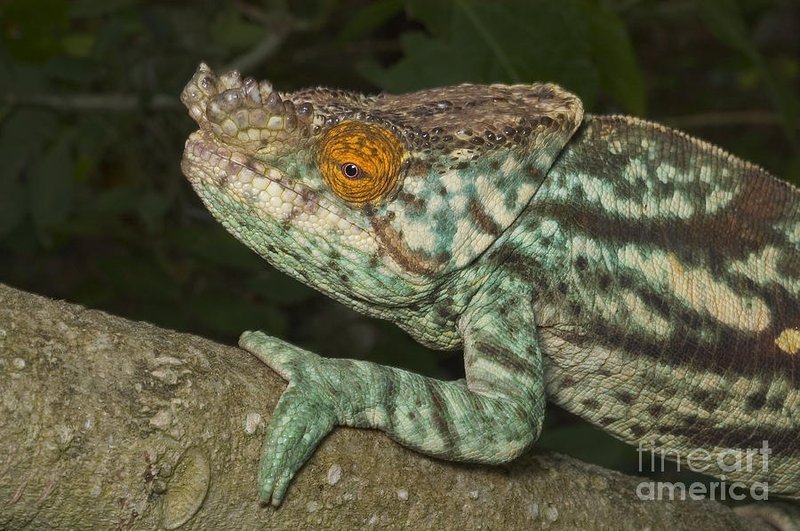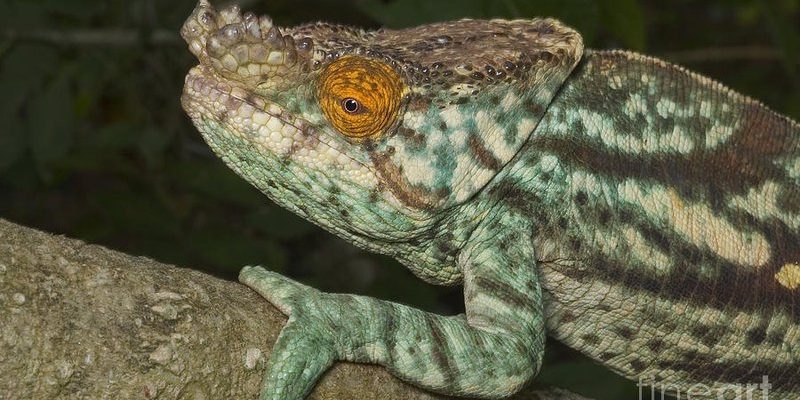
Imagine a creature that can change its appearance with a flick of its tongue—not due to magic, but because it’s a chameleon! The Parson’s Chameleon, scientifically known as Calumma parsonii, is one of the most fascinating of these color-changing reptiles. Found only in the lush landscapes of Madagascar, this chameleon is like a walking piece of art with its vibrant hues and unique personality.
With its distinctive looks and intriguing behaviors, the Parson’s Chameleon captures the imagination of many animal lovers and researchers alike. From their striking color changes to their impressive size, these reptiles offer us a glimpse into the marvels of evolution and adaptation. So, whether you’re a nature enthusiast or just curious, let’s dive into the world of the Parson’s Chameleon and discover what makes it so special.
Physical Characteristics
The Parson’s Chameleon is not your average chameleon in terms of size. In fact, it’s one of the largest chameleons in the world! Adult males can reach lengths of up to 27 inches, while females are slightly smaller. Their bodies are stout, and they have a distinctive crest that runs along the top of their head. This crest is similar to a crown, enhancing their regal appearance.
One of the most striking features of the Parson’s Chameleon is its ability to change colors. This isn’t just for show—these color changes are a way for the chameleon to communicate its mood, attract a mate, or even blend into its surroundings when threatened. You might see them shift from bright greens to deep blues or even yellows, reflecting their environment or emotional state.
Aside from color, their skin has tiny scales which add texture and help with camouflage. When you observe a Parson’s Chameleon perched on a branch, it’s incredible how well it blends in with the surrounding leaves. Their eyes are also noteworthy; they can move independently, allowing them to focus on two different things at once. This unique vision is handy for spotting both predators and prey!
Habitat and Range
The Parson’s Chameleon is native to Madagascar, an island known for its rich biodiversity. These chameleons prefer humid, tropical rainforests where the vegetation is thick. Their natural habitat provides both food and shelter, with plenty of branches to climb and insects to eat. They are often found in the canopies, where they can bask in the dappled sunlight filtering through the leaves.
Madagascar’s ecosystem is unique and fragile, with many species found nowhere else on Earth. By living in such a specific habitat, the Parson’s Chameleon plays a vital role in maintaining the balance of its environment. However, their specialized habitat also makes them vulnerable to changes like deforestation and habitat loss. Conservation efforts are crucial to protect these stunning reptiles and their forest homes.
Interestingly, Parson’s Chameleons are often solitary creatures. They can be territorial, especially males when vying for the attention of females during mating season. This territorial behavior can lead to vibrant displays of color and displays of strength to establish dominance. As they traverse their forest homes, they not only find food but also engage in these colorful competitions.
Behavior and Diet
When it comes to behavior, Parson’s Chameleons are captivating. They lead mostly arboreal lives, meaning they spend much of their time in trees. Their feet are specially adapted for climbing, with toes that can grip branches firmly. You may be surprised to learn that these chameleons are quite slow-moving, taking their time as they navigate through the foliage. This slow pace helps them avoid detection by both predators and prey.
Speaking of diet, Parson’s Chameleons are insectivores. Their menu largely consists of various insects, such as crickets, grasshoppers, and other small invertebrates. They possess long, sticky tongues that can extend rapidly to catch their prey. It’s a bit like tossing a fishing line; they sit patiently and wait for the perfect moment to strike! This unique feeding method means they can catch insects effectively without having to chase them down.
Besides insects, they also need to stay hydrated, often drinking water droplets that form on leaves after rain. In captivity, it’s essential for owners to replicate this by misting their habitats regularly to ensure their chameleons stay healthy and hydrated. Just imagine it: a bright green chameleon sipping water while perched on a branch, blending seamlessly into its surroundings!
Reproduction and Lifecycle
The mating season for Parson’s Chameleons typically occurs during the rainy months when food is abundant. Males usually display their vibrant colors and engage in battles to attract females. Once a female selects a mate, they will court each other before mating. After successful mating, the female lays eggs; the number can vary but is typically between 10 to 30 eggs.
Egg-laying is a crucial stage in their lifecycle. The female buries the eggs in a carefully chosen location, often in soft soil or leaf litter, where they will remain until they hatch. Incubation can take anywhere from 5 to 12 months, depending on environmental conditions. This long wait is a period of vulnerability for the eggs, and many factors can affect their survival.
Once the hatchlings emerge, they are miniature versions of their adult counterparts. They are independent from birth and must fend for themselves immediately. Young chameleons face many challenges, including predators and competition for food. It’s a tough world out there for a tiny chameleon, but those that survive will grow and eventually become part of the adult population!
Conservation Status
The Parson’s Chameleon is currently listed as vulnerable on the IUCN Red List due to habitat loss and fragmentation. As Madagascar’s forests are cut down for agriculture and logging, these chameleons lose their homes and food sources. Conservation efforts aim to protect their habitat and raise awareness about the importance of preserving Madagascar’s unique biodiversity.
There are various organizations working tirelessly to safeguard these reptiles. By creating protected areas and promoting sustainable practices, they strive to ensure that the Parson’s Chameleon and other endemic species can thrive. Education is also a key factor; by informing local communities about the importance of these creatures, they can help reduce poaching and habitat destruction.
If you’re passionate about wildlife conservation, there are many ways to get involved. Supporting conservation projects, spreading awareness, or even adopting a chameleon through a reputable organization can make a difference. Every action counts when it comes to protecting these marvelous creatures and their habitats.
Fascinating Facts
| Fact | Detail |
|---|---|
| Size | Adults can reach up to 27 inches long. |
| Habitat | Native to tropical rainforests in Madagascar. |
| Diet | Insectivores; primarily eat crickets and grasshoppers. |
| Color Change | Can change colors based on mood and environment. |
| Lifespan | Typically live 5 to 10 years in captivity. |
FAQ
What is the natural habitat of the Parson’s Chameleon?
The natural habitat of the Parson’s Chameleon is primarily the humid tropical rainforests of Madagascar. These lush environments provide both a food source and shelter, enabling the chameleons to thrive. The canopies of these forests offer plenty of foliage for them to climb and hunt insects, while also providing cover from potential predators.
How do Parson’s Chameleons change their color?
Parson’s Chameleons change their color through special pigment cells in their skin called chromatophores. By expanding or contracting these cells, they can create a stunning display of colors. This ability is not just for camouflage; it also serves as a means of communication, indicating their mood, health status, or readiness to mate.
Are Parson’s Chameleons kept as pets?
Yes, Parson’s Chameleons can be kept as pets, but they require specific care to thrive. They need a well-structured habitat that mimics their natural environment, including proper humidity, temperature, and access to live food. Potential owners should research extensively before adopting one, as they have particular needs that must be met to ensure their well-being.
What threats do Parson’s Chameleons face in the wild?
Parson’s Chameleons face several threats in their natural habitat, primarily due to human activities. Deforestation for agriculture and logging leads to habitat destruction, which is one of the biggest challenges they face. Poaching for the exotic pet trade also poses a significant risk to their populations, making conservation efforts essential for their survival.
How long do Parson’s Chameleons live in captivity?
In captivity, Parson’s Chameleons typically live between 5 to 10 years, provided they receive proper care. A suitable environment, a balanced diet, and regular veterinary check-ups can contribute to a longer and healthier life. Understanding their specific needs is crucial for any pet owner.
Can Parson’s Chameleons see in color?
Yes, Parson’s Chameleons can see in color! Their eyes are highly specialized and allow them to distinguish between a wide range of colors. This exceptional vision aids them in spotting both prey and predators in their vibrant green surroundings, enhancing their ability to survive in the wild.
What is the mating behavior of Parson’s Chameleons?
Mating behavior in Parson’s Chameleons is quite fascinating. Males display vibrant colors to attract females and often engage in physical displays to demonstrate strength and dominance. Once a female selects a mate, they will engage in courtship rituals before mating, laying the foundation for the next generation.
How can we help conserve Parson’s Chameleons?
Conservation of Parson’s Chameleons can be supported through various means. Participating in conservation programs, donating to wildlife organizations, or even spreading awareness about their plight can all help protect these unique reptiles. Supporting sustainable practices also ensures that their natural habitats remain intact.
Are there any significant differences between male and female Parson’s Chameleons?
Yes, there are several differences between male and female Parson’s Chameleons. Males are generally larger and possess more vibrant coloration, particularly during mating season. They also have more pronounced crests on their heads compared to females. These differences make it easier for them to attract mates and establish dominance within their territory.
What do Parson’s Chameleons eat in the wild?
In the wild, Parson’s Chameleons primarily consume a diet of insects. Their diet consists of various bugs, including crickets, grasshoppers, and other small invertebrates, which are readily available in their humid forest habitat. This insectivorous diet is essential for their growth and overall health.
Can Parson’s Chameleons be endangered?
Yes, Parson’s Chameleons are considered vulnerable and face risks of endangerment due to habitat loss and poaching. As conservation efforts are implemented, it is crucial to monitor their populations and habitats to prevent further decline. Protecting their natural environments and raising awareness about their plight is essential for their survival.

